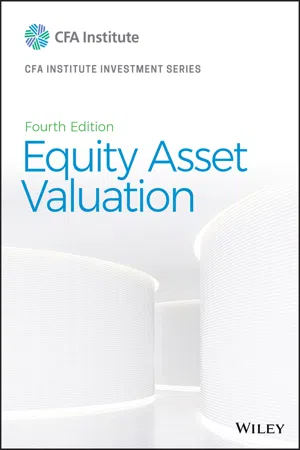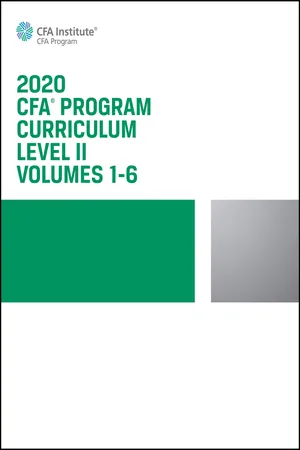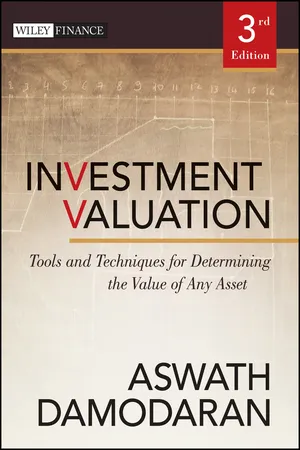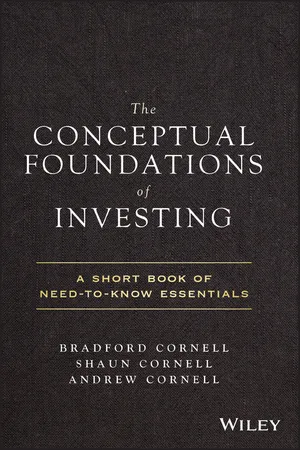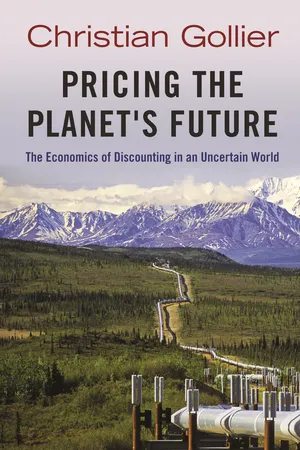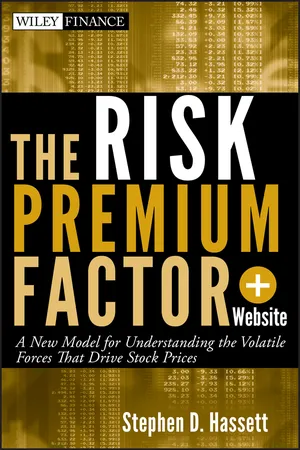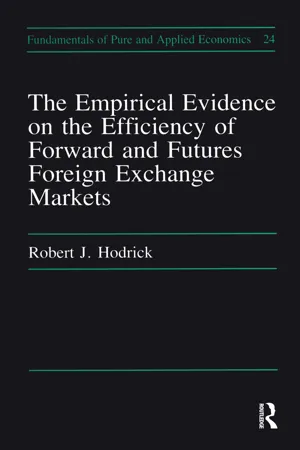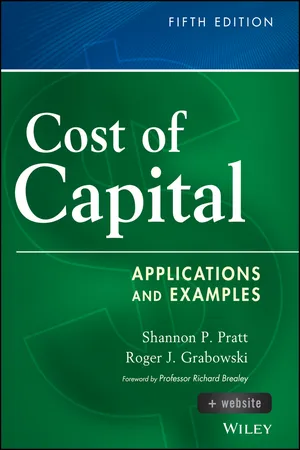Economics
Risk Premium
Risk premium refers to the additional return that investors demand for taking on a higher level of risk compared to a risk-free investment. It is the compensation for the possibility of experiencing losses due to fluctuations in the value of an investment. In essence, it represents the extra return required by investors to hold a risky asset.
Written by Perlego with AI-assistance
Related key terms
Related key terms
1 of 4
Related key terms
1 of 3
10 Key excerpts on "Risk Premium"
- eBook - ePub
Managing And Measuring Of Risk: Emerging Global Standards And Regulations After The Financial Crisis
Emerging Global Standards and Regulations After the Financial Crisis
- Oliviero Roggi, Edward I Altman(Authors)
- 2013(Publication Date)
- WSPC(Publisher)
∗ This is the fifth update of this piece. The first update was in the midst of the banking crisis in 2008 and there were annual updates for 2009, 2010 and 2011.non-equity markets. We also look at the relationship between the equity Risk Premium and Risk Premiums in the bond market (default spreads) and in real estate (cap rates) and how that relationship can be mined to generated expected equity Risk Premiums. We close the chapter by examining why different approaches yield different values for the equity Risk Premium, and how to choose the “right” number to use in analysis.The notion that risk matters, and that riskier investments should have higher expected returns than safer investments, to be considered good investments, is intuitive and is central to risk and return models in finance. Thus, the expected return on any investment can be written as the sum of the riskfree rate and a Risk Premium to compensate for the risk. The disagreement, in both theoretical and practical terms, remains on how to measure the risk in an investment, and how to convert the risk measure into an expected return that compensates for risk. A central number in this debate is the premium that investors demand for investing in the ‘average risk’ equity investment (or for investing in equities as a class), i.e., the equity Risk Premium.In this chapter, we begin by examining competing risk and return models in finance and the role played by equity Risk Premiums in each of them. We argue that equity Risk Premiums are central components in every one of these models and consider what the determinants of these premiums might be. We follow up by looking at three approaches for estimating the equity Risk Premium in practice. The first is to survey investors or managers with the intent of finding out what they require as a premium for investing in equity as a class, relative to the riskfree rate. The second is to look at the premiums earned historically by investing in stocks, as opposed to riskfree investments. The third is to back out an equity Risk Premium from market prices today. We consider the pluses and minuses of each approach and how to choose between the very different numbers that may emerge from these approaches. - eBook - ePub
- Jerald E. Pinto(Author)
- 2020(Publication Date)
- Wiley(Publisher)
The equity Risk Premium, like the required return, depends strictly on expectations for the future because the investor’s returns depend only on the investment’s future cash flows. Possibly confusingly, equity Risk Premium is also commonly used to refer to the realized excess return of stocks over a risk-free asset over a given past time period. The realized excess return could be very different from the premium that, based on available information, was contemporaneously being expected by investors. 10 Using the equity Risk Premium, the required return on the broad equity market or an average-systematic-risk equity security is Required return on equity = Current expected risk-free return + Equity risk premium where, for consistency, the definition of risk-free asset (e.g., government bills or government bonds) used in estimating the equity Risk Premium should correspond to the one used in specifying the current expected risk-free return. The importance of the equity Risk Premium in valuation is that, in perhaps a majority of cases in practice, analysts estimate the required return on a common equity issue as either (4) or (5) Equation 4 adjusts the equity Risk Premium for the share’s particular level of systematic risk as measured by beta (β i)—an average systematic risk security has a beta of 1, whereas beta values above and below 1 indicate greater-than-average and smaller-than-average systematic risk. Equation 4 will be explained in Section 4.1 as the capital asset pricing model (CAPM). Equation 5 does not make a beta adjustment to the equity Risk Premium but adds premia/discounts required to develop an overall equity risk adjustment. Equation 5 will be explained in Section 4.3 as the build-up method for estimating the required return - (Author)
- 2019(Publication Date)
- Wiley(Publisher)
In this example, the price discount is not too large because the risk between a one- and two-year US government bond is not that crucial. However, more risky assets, such as equity, will have a higher discount. In addition, the higher Risk Premium on equity still follows from the covariance between the cash flow and the investor’s willingness to invest over the time horizon of the investment. Thus, a higher Risk Premium for stocks arises from a larger value for this covariance.The Risk Premium can be computed as follows: The expected holding period return on the s period bond through time t + 1, using the results of Example 5 , is given byEquation (7)so the Risk Premium = rt,s – lt ,1 = 0.047681 – 0.047671 = 0.00001.Alternatively, Equations 7 and 6 can be manipulated so that14Equation (8)which is the return premium demanded by investors because of the uncertain Time 1 price of the riskless two-period bond.This relationship implies that an asset’s Risk Premium, in Equation 1 , is driven by the covariance of its returns with the inter-temporal rate of substitution for consumption, and can exist even for a default-free bond because of the uncertainty of its price before maturity. Most risky assets have returns that tend to be high during good times, when the marginal value of consumption is low, and low during bad times, when the marginal value of consumption is high, and so bear a positive Risk Premium. Any asset that tended to have relatively high returns when the marginal utility of consumption was high would provide a type of hedge against bad times and bear a negative Risk Premium and have a relatively high price and low required rate of return.3.2 . Default-Free Interest Rates and Economic Growth
From the previous discussion, it is a relatively small conceptual step to understand the relationship between an economy’s GDP growth and real default-free interest rates. If there is a known independent change in the real GDP growth, or a change that can be forecasted perfectly, then an increase in real GDP growth should lead to an increase in the real default-free rate of interest because more goods and services will be available in the future relative to today. The result is that investors’ willingness to substitute across time will fall, resulting in less saving and more borrowing, so that the real default-free interest rate increases, as in Equation 4- eBook - ePub
Investment Valuation
Tools and Techniques for Determining the Value of Any Asset
- Aswath Damodaran(Author)
- 2012(Publication Date)
- Wiley(Publisher)
The notion that risk matters, and that riskier investments should have a higher expected return than safer investments to be considered good investments, is intuitive. Thus, the expected return on any investment can be written as the sum of the risk-free rate and an extra return to compensate for the risk. The disagreement, in both theoretical and practical terms, remains on how to measure this risk, and how to convert the risk measure into an expected return that compensates for risk. This section looks at the estimation of an appropriate equity Risk Premium (ERP) to use in risk and return models, in general, and in the capital asset pricing model, in particular.Competing Views on Risk PremiumsIn Chapter 4, we considered several competing models of risk ranging from the capital asset pricing model to multifactor models. Notwithstanding their different conclusions, they all share some common views about risk. First, they all define risk in terms of variance in actual returns around an expected return; thus, an investment is riskless when actual returns are always equal to the expected return. Second, they all argue that risk has to be measured from the perspective of the marginal investor in an asset, and that this marginal investor is well diversified. Therefore, the argument goes, it is only the risk that an investment adds on to a diversified portfolio that should be measured and compensated. In fact, it is this view of risk that leads models of risk to break the risk in any investment into two components. There is a firm-specific component that measures risk that relates only to that investment or to a few investments like it, and a market component that contains risk that affects a large subset or all investments. It is the latter risk that is not diversifiable and should be rewarded. - eBook - ePub
Finance and the Behavioral Prospect
Risk, Exuberance, and Abnormal Markets
- James Ming Chen(Author)
- 2016(Publication Date)
- Palgrave Macmillan(Publisher)
© The Author(s) 2016 James Ming Chen Finance and the Behavioral Prospect Quantitative Perspectives on Behavioral Economics and Finance https://doi.org/10.1007/978-3-319-32711-2_7Begin Abstract7. The Equity Risk Premium and the Equity Premium Puzzle
End AbstractJames Ming Chen 1(1) College of Law, Michigan State University, East Lansing, Michigan, USA7.1 The Equity Risk Premium
All of finance rests on the proposition that investors dislike risk and demand higher returns as compensation for bearing risk. In behavioral terms, the equity Risk Premium may be regarded as the additional rate of return that risk-averse investors, as a class, demand in exchange for the burden of bearing volatility and the attendant risk of downside loss. Although one study has concluded that the replacement of standard deviation in the conventional CAPM by a downside risk measure would advise investors to lower the stock allocations within their portfolios,1another study suggests that investors’ reliance on fixed-income positions vastly exceeds the allocation that any strictly rational, utilitarian evaluation of risk in equity investing would ever counsel.2Given the presence of a “sizeable equity premium,” why indeed should “a substantial fraction of investable wealth [be] invested in fixed income instruments”?3But the extent of this premium comes as an econometric shock and presents a persistent, still unresolved puzzle. In their original 1985 formulation of the “equity premium puzzle,” Rajnish Mehra and Edward Prescott found that “the average real annual yield on equity” in hypothetically “competitive pure exchange economies” should be “a maximum of four-tenths of a percent higher than that on short-term debt,” a surrogate for the risk-free rate.4This result stood “in sharp contrast to the six percent premium observed” in Mehra and Prescott’s actual survey of American economic history.5 - eBook - ePub
The Conceptual Foundations of Investing
A Short Book of Need-to-Know Essentials
- Bradford Cornell, Shaun Cornell, Andrew Cornell(Authors)
- 2018(Publication Date)
- Wiley(Publisher)
2 There is, however, a path forward related to our discussion of stocks, bonds, and bills. Although expected returns are not observable, past returns are. If we can come up with a measure of risk, then it would be possible to examine whether riskier securities have provided greater past average returns. That is the path that research in finance has followed.The phrase “risk–return trade-off” seems to imply that if an investor bears risk he or she will be rewarded with greater expected returns, but that is not the case. It is not risk per se that warrants a premium, it is economic risk that cannot be avoided or eliminated by diversification. First, with regard to avoidable risks, most gambling falls into this category. As noted earlier, if my friend and I bet on a football game, we both bear risk but we can't both earn Risk Premiums. So who gets the premium? The answer is neither of us. The risk can be entirely avoided by just not betting on the game. This is not a risk that society must bear as part of ongoing economic activity.In this respect, buying Apple stock is different. Apple requires investors to provide it with financing as part of its operation. Therefore, the risk of holding Apple stock is not a risk that can be avoided. Someone must bear the risk if we are to have our iPhones. This makes it sound like the volatility of Apple stock would be the appropriate measure of risk, but that too is wrong. Investors do not have to bear all of that risk, because of diversification.To appreciate the impact of diversification, consider the risk of fire damage that homeowners face. For millions of homeowners nationwide this is clearly a risk that cannot be avoided. Typically homeowners are unwilling to bear the risk, so they transfer the risk to insurance companies in the form of a homeowner's policy. From this it seems to follow that the insurance companies should receive a substantial premium for bearing the risk. And while insurance companies do earn a premium, it is much smaller than you would guess based on the risk that individual homeowners face. The reason the premium is small is because insurance companies can drastically reduce the risk by diversifying across hundreds of thousands of policies. - eBook - ePub
Pricing the Planet's Future
The Economics of Discounting in an Uncertain World
- Christian Gollier(Author)
- 2012(Publication Date)
- Princeton University Press(Publisher)
Investors in financial markets have the opportunity to invest in a large set of projects. Their optimal asset allocation is such that they are indifferent at the margin to a transfer of wealth from one asset to any other one. This is why two safe assets with the same maturity must have the same return. By risk aversion, if an asset has a cash flow that correlates positively with aggregate risk in the economy, its equilibrium price is smaller than the corresponding safe asset with the same expected payoff at the same maturity. In other words, the expected return of the risky asset is greater than the return on the safe asset. This means that investors discount the expected cash flows of the risky asset at a higher rate. This “equity premium” tells us something important about our collective preferences: Risky projects should be undertaken only if their expected internal rate of social return is large enough to compensate for the increased risk that it yields for the stakeholders. The social planner should do the same to evaluate risky public investments. This chapter is devoted to the analysis of the Risk Premium for risky projects that should be added to the discount rate for safe projects. Dimson, Marsh, and Staunton (2002) have computed the annualized return on bonds and equities for different countries during the twentieth century. Using extended data from the same authors over the period 1900–2006, the main facts are summarized in table 12.1. In the United States, the return on T-bills, which are probably the safest assets in the world, gave a real return of around 1.0%, whereas 10-year Treasury bonds and equities delivered an average real return of respectively 1.9% and 6.6% per year. This implies an equity premium of around 5.6%. The real return of these three asset classes varies significantly across different countries during the period - eBook - ePub
The Risk Premium Factor
A New Model for Understanding the Volatile Forces that Drive Stock Prices
- Stephen D. Hassett(Author)
- 2011(Publication Date)
- Wiley(Publisher)
Part One Exploring the Risk Premium Factor Valuation ModelPassage contains an image Chapter 2 The Risk Premium Factor Valuation Model
The Risk Premium Factor (RPF) Model proposes that the equity Risk Premium (ERP) is a simple function of the risk-free rate. When combined with simplifying assumptions as inputs to the constant growth equation, it explains the observed variation in ERP and changes in price-to-earnings (P/E) ratios and valuations for the Standard & Poor's (S&P) 500 over the past 50 years.Conventional theory would hold that if the equity Risk Premium (ERP) were 6.0 percent and 10-year Treasury yield were 4.0 percent, then investors would expect equities to yield 10 percent, but if the 10-year Treasury were 10 percent, then investors would require a 16 percent return—a proportionately smaller premium. I argue that the ERP is not fixed as in the conventional Capital Asset Pricing Model (CAPM) and cannot be determined by looking back or projecting forward, but varies directly with the level of the risk-free rate in accordance with a Risk Premium factor (RPF). While this proportional RPF is fairly stable, it can and does change over longer periods of time.To illustrate the concept, with an RPF of 1.48, equities are expected to yield 9.9 percent when Treasury yields are at 4.0 percent and 24.8 percent (10 + 1.48 × 10 = 24.8) when they are at 10 percent to provide investors with the same proportional compensation for risk. In this example, the increase in interest rates (and inflation) caused the Risk Premium to jump from about 6 percent to 15 percent. Notice that with this approach, the cost of capital is lower than with a fixed premium when interest rates are low, but higher than the fixed premium approach when interest rates are high. This implies that interest rates have a greater impact on valuation and market price than generally recognized.In order to test this approach, we not only need to determine the RPF, but also determine estimates for other variables. For our long-term growth rate, we simply assume that earnings will grow at the same pace as the economy. This is broken into its components of real growth plus expected inflation. A long-term real growth forecast is provided in the annual federal budget and tends to be stable, even when the economy is not. Inflation is determined by subtracting the underlying real interest rate (the rate without inflation) from the risk-free rate. We apply this to the constant growth equation: - Robert J. Hodrick(Author)
- 2023(Publication Date)
- CRC Press(Publisher)
5. ECONOMETRIC MODELS OF Risk PremiumS
DOI: 10.1201/9781003420385-5The previous section explored alternative interpretations of the rejection of the unbiasedness hypothesis. While market inefficiency is not a totally implausible hypothesis, a time-varying Risk Premium is perhaps a more likely explanation given the abundant evidence that average holding period returns on assets have varied greatly. Ibbotson and Sinquefield [114 ,115 ] document the existence of large differences in the average holding period returns on a variety of assets. Most financial economists view these differences as a reflection of Risk Premiums that are potentially traceable to risk aversion of individual investors. If agents are risk averse, the asset market theory of exchange rate determination combined with the intertemporal asset pricing theory discussed in Section 2 suggests that Risk Premiums ought to characterize the forward market for foreign exchange.In this section I examine alternative econometric models of the Risk Premium. First, models that are based strictly on the time series properties of spot and forward exchange rates and asset prices are considered. Then, models that employ other market fundamentals are examined.5.1. Models with no market fundamentals
There is a long tradition in financial economics of developing tests of asset pricing models that utilize only the comparatively accurately measured returns on assets. Other data that are fundamental from an economic perspective are ignored. This section discusses several tests of asset pricing models that do not incorporate market fundamentals such as the outstanding stocks of assets. Models that incorporate market fundamentals are discussed in Section 5.2.In Section 2 a conditional capital asset pricing model is derived in (2.23). This expression is repeated here for convenience as (5.1) since it forms the basis of the empirical models of this section. The representation of the expected normalized profit on a long position in the forward market is- eBook - ePub
Cost of Capital
Applications and Examples
- Shannon P. Pratt, Roger J. Grabowski(Authors)
- 2014(Publication Date)
- Wiley(Publisher)
Chapter 8Equity Risk Premium1- Introduction
- Defining the Equity Risk Premium
- Nominal or Real?
- Estimating the ERP
- ERP Is Measured Relative to a Risk-free Rate
- Measuring the Average Period of the Expected Cash Flows
- Unconditional ERP
- Selecting a Sample Period of ex post Data
- Bias in Realized Risk Premium Data
- Predicting Future ERP
- Has the Relationship between Stock and Bond Risk Changed?
- Comparing Investor Expectations to Realized Risk Premiums
- Causes of Unexpectedly Large Realized Risk Premiums
- Unconditional ERP Estimates
- Conditional ERP
- Forward-looking (ex ante) Approaches
- Predicting Future ERP
- Conditional ERP Estimates
- Concluding on an ERP
- Summary
- Additional Reading
- Appendix 8A: Deriving ERP Estimates
- Appendix 8B: Other Sources of ERP Estimates
Introduction
The equity Risk Premium (ERP) (often interchangeably referred to as the market Risk Premium) is defined as the extra return (over the expected yield on risk-free securities) that investors expect to receive from an investment in the market portfolio of common stocks, represented by a broad-based market index (e.g., S&P 500 Index or the NYSE Index).As Arnott comments:For the capital markets to “work,” stocks should produce higher returns than bonds. Otherwise, stockholders would not be paid for the additional risk they take for being lower down in the capital structure. This relationship should be particularly true when stocks are compared to government bonds that (ostensibly) cannot default.2In a recent paper, the authors conclude that “The ERP is almost certainly the most important variable in finance.”3The effect of a decision that the appropriate ERP is 4% instead of 8% in the capital asset pricing model (CAPM) will generally have a greater impact on the concluded discount rate than alternative theories of the proper measure of other components, such as beta. One academic study looked at sources of error in estimating expected rates of return over time and concluded:
Index pages curate the most relevant extracts from our library of academic textbooks. They’ve been created using an in-house natural language model (NLM), each adding context and meaning to key research topics.
Explore more topic indexes
Explore more topic indexes
1 of 6
Explore more topic indexes
1 of 4

